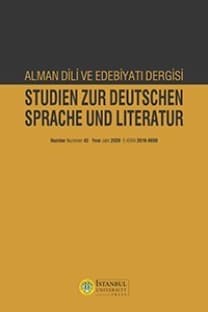So weiß als Schnee, und so roth als Blut. Zur ästhetischen Inszenierung der schönen Toten in den verschiedenen Fassungen des Grimmschen Märchens Sneewittchen (KHM 53)
Anahtar Kelimeler:
weiblicher Tod, Schönheit, ästhetischer Fetisch, männlicher Blick, Trauerkult
As white as snow, as red as blood:The aesthetic mise-en-scène of the beautiful corpse in various versions of the Grimm fairy tale Snow White (KHM 53)The aesthetic connection between female beauty and the melancholy of death, which Edgar Allan Poe declared central to perfect poetic expression in 1846, finds its apotheosis in the Grimm Brothers’ fairy tale Snow White. In the aesthetic miseen-scène of death, the beautiful female corpse in the glass coffin becomes an object of observation for the male gaze and is sublimated into an idealized, venerable image. By considering theories of fetishism, it becomes clear that the beautiful corpse -- an exhibited object removed from any means of direct contact -- is stylized as an aesthetic fetish. Since Snow White’s corpse is displayed publicly and is visible to all, the gaze, transformed into an aesthetic gesture, ultimately provides the sole possible means of reaching the otherwise distant object of desire. The cult of mourning even transforms into a ceremony of religious devotion in individual versions of the Grimm fairy tale, as well as in heightened form in the 1937 Walt Disney film. If Snow White’s beauty is so incomparable it represents an extreme in life, it follows that her corpse, which cannot decay and is not beholden to the laws of nature, also follows this narrative logic: in death, Snow White’s preserved corpse symbolizes exactly that claim to absoluteness and to eternity which the Queen demands for herself and seeks to claim through the poisoned apple.
___
Hand, David D. (1937): Snow White and the Seven Dwarfs, DVD, 83 min., United States of America.Rölleke, Heinz (Hg.) (1997): Brüder Grimm. Kinder- und Hausmärchen. Ausgabe letzter Hand. Mit einem Anhang sämtlicher nicht in allen Auflagen veröffentlichter Märchen, Stuttgart.
Rölleke, Heinz (Hg.) (1975): Die Älteste Märchensammlung der Brüder Grimm. Synopse der handschriftlichen Urfassung von 1810 und der Erstdrucke von 1812. Herausgegeben und erläutert von Heinz Rölleke (Bibliotheca Bodmeriana. Texte, 1), Cologny / Genève.
Ariès, Philippe (1981): Studien zur Geschichte des Todes im Abendland. Aus dem Französischen von Hans-Horst Henschen, München [Paris 1975].
Baudrillard, Jean (1994): „The System of Collecting“, in: Elsner, John/Cardinal, Roger (Hg.): The Cultures of Collecting, London, S. 7–24.
Böhme, Hartmut (2006): Fetischismus und Kultur. Eine andere Theorie der Moderne, Reinbek bei Hamburg.
Bronfen, Elisabeth (1994): Nur über ihre Leiche. Tod, Weiblichkeit und Ästhetik, 2. Aufl., München.
Drewermann, Eugen (2003): Schneewittchen, die zwei Brüder. Grimms Märchen tiefenpsychologisch gedeutet, München.
Flagmeier, Renate (2003): „Das Museum. Ein Mausoleum der Dinge?“, in: Kallinich, Joachim / Bratthauer, Bastian (Hg.): Botschaft der Dinge (Katalog der Museumsstiftung Post und Telekommunikation, 18), Heidelberg, S. 175–186.
Freund, Winfried (1996): Deutsche Märchen. Eine Einführung, München.
Hofius, Annegret (1986): „Sneewittchen oder die Schöne und das Böse“, in: Solms, Wilhelm / Oberfeld, Charlotte (Hg.): Das selbstverständliche Wunder. Beiträge germanistischer Märchenforschung (Marburger Studien zur Literatur, 1), Marburg, S. 63–83.
Hufeland, Christoph Wilhelm (1808): Der Scheintod, oder Sammlung der wichtigsten Thatsachen und Bemerkungen darüber in alphabetischer Ordnung, Berlin. Jones, Steven Swann (1990): The New Comparative Method: Structural and symbolic analysis of the allmotifs of ‚Snow White῾ (FF Communications, 247), Helsinki.
Lüthi, Max (1975): Das Volksmärchen als Dichtung. Ästhetik und Anthropologie, Düsseldorf / Köln
Lüthi, Max (1989): So leben sie noch heute. Betrachtungen zum Volksmärchen, 3. Aufl., Göttingen.
Poe, Edgar Allan (1984): “The philosophy of composition”, in: Ders.: Essays and Reviews. Theory of Poetry, Reviews of British and Continental Authors, Reviews of American Authors and American Literature, Magazines and Criticism, The Literary and Social Scene, Articles and Marginalia (The library of America, 20), 3. Aufl., New York, S. 13–25.
Röhrich, Lutz (1999): „Die Tote im Glassarg. Schneewittchen und andere schöne Tote in der Volksliteratur“, in: Jung-Kaiser, Ute (Hg.): … ‚das poetischste Thema der Welt῾? Der Tod einer schönen Frau in Musik, Literatur, Kunst, Religion und Tanz. 1. Interdisziplinäres Symposion der Hochschule für Musik und Darstellende Kunst. Frankfurt 1999. Bern u.a., S. 53–81.
Röhrich, Lutz (2004): „Schneewittchen – Ein Beitrag zur volkskundlichen und literaturwissenschaftlichen Erzählforschung“, in: Franz, Kurt (Hg.): Märchenwelten. Das Volksmärchen aus der Sicht verschiedener Fachdisziplinen (Schriftenreihe Ringvorlesungen der Märchen-Stiftung Walter Kahn, 1), Baltmannweiler, S. 5–33.
- Başlangıç: 1954
- Yayıncı: İstanbul Üniversitesi
Sayıdaki Diğer Makaleler
Nostalgie, Utopie und Spiel in Märchenerzählungen der deutschen Gegenwartsliteratur
Rafik Schami’s Tales about Fairy Tales
Sabrina / Juliane GEİLERT / VOORGANG
Euro-Wiss Tagung: “Universitäre Lehr-Lern-Diskurse komparativ” Università degli Studi di Bergamo
